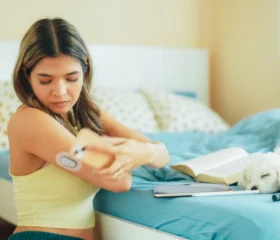Preventing and Treating Diabetes-Related Retinopathy

More than one-third of people living with diabetes have diabetes-related retinopathy. It is the most common cause of vision loss in people with diabetes and the leading cause of blindness in working-age adults. Across the globe, diabetes-related eye disease affects about 103 million individuals and is projected to rise to 161 million by 2045. In addition to the estimated 9.6 million people with diabetes-related retinopathy in the United States, it is expected that 14.6 million people will develop the condition over the next 30 years. Finding and treating retinopathy early can reduce the risk of blindness by 95 percent.
What is diabetes-related retinopathy?
The retina, a light-sensitive layer of cells in the back of the eye, enables us to see clearly. Images are imprinted on the retina much like film in a camera. Blood vessels in the retina nourish the cells in the retina. Over time, high blood glucose can cause these blood vessels to weaken and leak, resulting in diabetes-related retinopathy. Typically, both eyes are affected. Eye care professionals describe two stages of the condition.
In the early stage, known as non-proliferative retinopathy, blood vessels may swell and leak fluid or blood. This can lead to swelling in the retina and the formation of deposits called exudates. If left untreated, the condition can progress to proliferative retinopathy, where new, fragile blood vessels grow on the retina’s surface. These abnormal vessels can bleed into the vitreous, the gel-like substance filling the eye, leading to severe vision impairment or blindness. Regular eye exams are essential for detecting retinopathy early, allowing for timely intervention to prevent progression and preserve vision. Maintaining good control of blood glucose, blood pressure, and cholesterol levels also plays a crucial role in managing and preventing diabetes-related retinopathy.
Who is most at risk for diabetes-related retinopathy?
Anyone with type 1 diabetes (T1D), type 2 diabetes (T2D), or gestational diabetes (diabetes while pregnant) can develop diabetes-related retinopathy. The longer you have diabetes, the more likely you are to develop it. Other factors can also increase your risk:
- High blood glucose (sugar)
- High blood pressure
- High cholesterol (lipid) levels
- Smoking
- Race/ethnicity: (African Americans, Hispanics/Latinos, and American Indians/Alaska Natives are at higher risk)
Diabetes-related retinopathy symptoms
Diabetes-related retinopathy often has no warning signs in the early non-proliferative stage, making regular eye exams essential for detection. As the condition progresses, you may notice symptoms such as:
- Blurred Vision: Difficulty seeing clearly, which can affect your ability to read or drive.
- Floaters: Seeing spots or dark strings that float in your vision.
- Dark or Empty Areas: Loss of vision in certain areas of your field of view.
- Poor Night Vision: Difficulty seeing in low light or at night.
- Color Vision Changes: Colors may appear faded or washed out.
If you experience any of these symptoms, it’s crucial to contact your eye care professional immediately. Early detection and treatment can prevent further damage and preserve your vision. Regular eye exams and maintaining control of your blood glucose levels are key to managing and preventing retinopathy.
Stages of diabetes-related retinopathy
Diabetes-related retinopathy progresses through distinct stages that can lead to significant vision problems if untreated. Understanding these stages is crucial for early detection and effective management.
Non-proliferative diabetes-related retinopathy (early stage):
In this early stage, blood vessel walls in the retina weaken and bulge, forming tiny pouches. These pouches can leak blood and other fluid, which can cause a part of the retina called the macula to swell (macular edema) and distort your vision. Macular edema is the most common cause of blindness in people with diabetes-related retinopathy. About half of people with this disease will develop macular edema.
There are often no symptoms in the early stages. That’s why it’s very important to get a dilated eye exam at least once a year to catch any problems early when treatment is most effective. During your eye exam, your eye care professional will check how well you are able to see the details of letters from a distance. Your eye care professional will also look at the retina and inside of your eyes. Often a dye is used to reveal leaky blood vessels. If you are diagnosed with diabetes-related retinopathy, your eye care professional may want to check your vision more often than once a year.
People newly diagnosed with T2D should have a comprehensive, dilated eye exam right away. Those with T1D should be checked within five years of diagnosis, Thereafter, eye exams should be scheduled every year. The sooner diabetes-related retinopathy is identified and treated, the better the treatment will work. Developing diabetes when pregnant (gestational diabetes) or having diabetes before pregnancy can increase the risk of retinopathy. If you’re pregnant, your eye care professional might recommend additional eye exams during your pregnancy.
Proliferative diabetes-related retinopathy (late stage):
In this stage, the retina begins to grow new blood vessels. These new, fragile vessels often bleed into the clear gel between the lens and retina known as the vitreous. If the bleeding is minor, you may see a few dark spots in your vision, called floaters. If there is more bleeding, your vision may be completely blocked. Symptoms to watch for in the advanced stage include floaters, blurred or dark vision, and poor night vision.
Contact your eye care professional right away if you experience these symptoms or if your vision changes suddenly, becoming blurry, spotty or hazy or if you see flashes. You should see your eye care professional right away if it looks like a curtain is pulled over your eyes as this could indicate a detached retina, requiring immediate treatment.
Diabetes-related retinopathy treatment
The best way to care for diabetes-related retinopathy in the early stages is to manage your diabetes through lifestyle and therapies to lower blood glucose, blood pressure, and blood cholesterol.
- Get a dilated eye exam at least once a year to detect any problems early when treatment will be most effective. In the meantime, be alert to any vision changes and contact your eye care professional as needed.
- Acquire a healthy lifestyle. This includes eating healthy and being active. If you already have diabetes-related retinopathy, check with your healthcare provider before starting to exercise. More on healthy lifestyle coming in article 5.
- Keep your blood glucose levels in your target range as much as possible. High blood glucose in the short term can affect the shape of your lenses causing blurry vision. High blood glucose over time damages blood vessels in your eyes. Regularly monitoring your glucose with either a blood glucose meter or a continuous glucose monitoring system will help you keep on track.
- Keep your blood pressure and cholesterol (lipid) levels in your target range to lower your risk for eye diseases and vision loss and improve your health in general.
- If you smoke, quit smoking. Quitting smoking will improve your health and lowers your risk for diabetes-related eye diseases.
As the disease progresses to the more advanced proliferative stage, new, fragile blood vessels will begin to grow, causing blurry vision, floaters, and possibly blindness. There are treatments available for advanced diabetes-related retinopathy including injections into the eye to slow the growth of new and unusual blood vessels, laser therapy to stop the bleeding of vessels and surgery.
Medications
Your doctor may treat your eyes with Anti-Vascular- Endothelial Growth Factor (anti-VEGF) medicine:
- Aflibercept (Eylea)
- Bevacizumab (Avastin)
- Ranibizumab (Lucentis).
These medicines block the growth of abnormal blood vessels in the eye. Anti-VEGF medicines can also stop fluid leaks, which can help treat diabetes-related macular edema. After numbing your eyes, your eye care professional will inject an anti-VEGF medicine into your eyes. The needle is about the thickness of a human hair. You’ll have several treatments during the first few months, then fewer treatments as you progress. These treatments, which occur during office visits can stop further vision loss and even improve vision for some and may be an alternative to laser treatments.
Common categories of medications to manage high blood pressure such as ACE inhibitors and ARBs can also help prevent or slow the development of retinopathy.
Laser treatment
Laser treatment, also called laser photocoagulation, creates tiny burns inside the eye with a beam of light. This creates scar tissue which serves as a barrier to slow down the growth of new blood vessels. This method treats leaky blood vessels and is provided during several office visits, using medicine to numb the eyes. While laser treatment can keep eye disease from getting worse, it is less likely to restore vision you have already lost. There are two types of laser treatments:
- Focal/grid laser treatment works on a small area of the retina to treat diabetes-related macular edema.
- Scatter laser treatment or pan-retinal photocoagulation (PRP), covers a larger area of the retina. This method treats the growth of abnormal blood vessels, called proliferative diabetes-related retinopathy.
Vitrectomy is a surgery to remove the clear gel that fills the center of the eye, called the vitreous gel. The procedure treats problems with severe bleeding or scar tissue caused by proliferative diabetes-related retinopathy. During vitrectomy, a clear salt solution is gently pumped into the eye to maintain eye pressure during surgery and to replace the removed vitreous. Vitrectomy is done in a surgery center or hospital. Scar tissue can cause retinal detachment. A retina that comes completely detached can cause blindness. The retina can be reattached if treated right away.
What if I have already lost vision?
Ask your eye care professional to help you find a low vision rehabilitation clinic or referral to a low-vision specialist. Low vision eye care professionals can help you manage vision loss that cannot be corrected with glasses, contact lenses, medicine, or surgery. Special devices and training may help you make the most of your remaining vision so that you can continue to be active, enjoy hobbies, visit friends and family members, and live independently.
Prevent vision loss today
What one action step can you take to manage your diabetes to help prevent vision loss? Remember, diabetes doesn’t have to lead to vision loss. Taking an active role in diabetes management can go a long way toward preventing complications. To learn more about how to manage your diabetes, ask your doctor to refer you to a certified diabetes care and education specialist (diabetes educator).
References:
Wong TY, Tan TE. The Diabetic Retinopathy “Pandemic” and Evolving Global Strategies: The 2023 Friedenwald Lecture. Invest Ophthalmol Vis Sci. 2023 Dec 1;64(15):47. doi: 10.1167/iovs.64.15.47. PMID: 38153754; PMCID: PMC10756246.
Lundeen EA, Burke-Conte Z, Rein DB, et al. Prevalence of Diabetic Retinopathy in the US in 2021. JAMA Ophthalmol. 2023;141(8):747–754. doi:10.1001/jamaophthalmol.2023.2289
https://www.cdc.gov/visionhealth/basics/ced/fastfacts.htm#:~:text=90%25%20of%20blindness%20caused%20by,and%20diminished%20quality%20of%20life. Accessed April 2, 2024.
American Diabetes Association Standards of Care in Diabetes—2024. Chapter 12. Retinopathy, Neuropathy, and Foot Care. Diabetes Care. 2024;47(Supplement 1):S231-S243.
Written by






